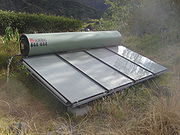
Soft energy technology
Encyclopedia

Renewable energy
Renewable energy is energy which comes from natural resources such as sunlight, wind, rain, tides, and geothermal heat, which are renewable . About 16% of global final energy consumption comes from renewables, with 10% coming from traditional biomass, which is mainly used for heating, and 3.4% from...
technologies which are not regarded as "soft".
Definition
More specifically, soft energy technologies have five defining characteristics. They rely on renewable energyRenewable energy
Renewable energy is energy which comes from natural resources such as sunlight, wind, rain, tides, and geothermal heat, which are renewable . About 16% of global final energy consumption comes from renewables, with 10% coming from traditional biomass, which is mainly used for heating, and 3.4% from...
resources, are diverse and designed for maximum effectiveness in particular circumstances, are flexible and relatively simple to understand, are matched to end-use needs in terms of scale, and are matched to end-use needs in terms of quality. An energy technology must satisfy all five of these criteria to be soft.
Residential solar energy technologies are prime examples of soft energy technologies and rapid deployment of simple, energy conserving
Energy conservation
Energy conservation refers to efforts made to reduce energy consumption. Energy conservation can be achieved through increased efficient energy use, in conjunction with decreased energy consumption and/or reduced consumption from conventional energy sources...
, residential solar energy technologies is fundamental to a soft energy strategy. Active residential solar technologies use special devices to collect and convert the sun's rays to useful energy and are located near the users they supply. Passive residential solar technologies (passive house
Passive house
The term passive house refers to the rigorous, voluntary, Passivhaus standard for energy efficiency in a building, reducing its ecological footprint. It results in ultra-low energy buildings that require little energy for space heating or cooling. A similar standard, MINERGIE-P, is used in...
) involve the natural transfer (by radiation, convection and conduction) of solar energy without the use of mechanical devices.
Sociological definition
The term soft is not meant to be vague, speculative, or ephemeral, but rather sustainable, flexible, resilient, and benign. Soft technology impacts are generally seen to be more "gentle, pleasant and manageable" than high technology impacts. These impacts range from the individual and household level to those affecting the very fabric of society at the national and international level. More specifically, favourable socio-political impacts include:- reduction in social conflicts and inequalities;
- reduction in population concentration;
- increase in employment, especially for the lower social classes;
- increase in the satisfaction of basic human needs;
- increase in consumer self-sufficiency; and
- increase in social participation and democratic processes.
The use of soft energy technologies, in conjunction with energy efficiency
Efficient energy use
Efficient energy use, sometimes simply called energy efficiency, is the goal of efforts to reduce the amount of energy required to provide products and services. For example, insulating a home allows a building to use less heating and cooling energy to achieve and maintain a comfortable temperature...
, and the transitional use of fossil fuel
Fossil fuel
Fossil fuels are fuels formed by natural processes such as anaerobic decomposition of buried dead organisms. The age of the organisms and their resulting fossil fuels is typically millions of years, and sometimes exceeds 650 million years...
technology, go to comprise the soft energy path
Soft energy path
In 1976 energy policy analyst Amory Lovins coined the term soft energy path to describe an alternative future where energy efficiency and appropriate renewable energy sources steadily replace a centralized energy system based on fossil and nuclear fuels....
.
See also
- Community wind energy
- Energy conservationEnergy conservationEnergy conservation refers to efforts made to reduce energy consumption. Energy conservation can be achieved through increased efficient energy use, in conjunction with decreased energy consumption and/or reduced consumption from conventional energy sources...
- Renewable energyRenewable energyRenewable energy is energy which comes from natural resources such as sunlight, wind, rain, tides, and geothermal heat, which are renewable . About 16% of global final energy consumption comes from renewables, with 10% coming from traditional biomass, which is mainly used for heating, and 3.4% from...
- Renewable energy commercializationRenewable energy commercializationRenewable energy commercialization involves the deployment of three generations of renewable energy technologies dating back more than 100 years. First-generation technologies, which are already mature and economically competitive, include biomass, hydroelectricity, geothermal power and heat...
- Efficient energy useEfficient energy useEfficient energy use, sometimes simply called energy efficiency, is the goal of efforts to reduce the amount of energy required to provide products and services. For example, insulating a home allows a building to use less heating and cooling energy to achieve and maintain a comfortable temperature...

